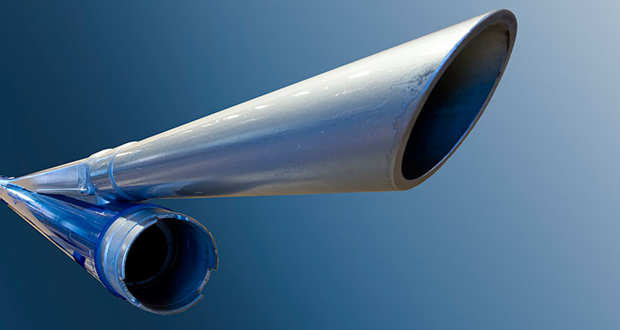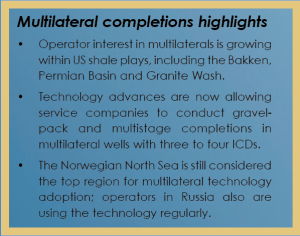Geometric evolution

Industry weighs complexity, risks as multilateral completion technologies advance

By Katie Mazerov, Contributing Editor
In an industry not prone to taking leaps of faith, multilateral completions have yet to make that pivotal niche-to-mainstream transition. Instead, it has remained a slow, steady and evolving market driven by operators’ push to maximize recovery with better economics, especially in the deepwater sector. To a great degree, adoption of multilateral completions is defined by region and by a select group of operating companies that have reached a certain comfort level with the technology. Introduced more than 20 years ago, multilateral completions are a recognized method for increasing reservoir contact and reducing the environmental footprint. Cost, risk, complexity and expertise remain barriers, however.
Complicated multilateral operations can be a daunting and expensive undertaking due to its need for multiple pieces of equipment across product lines and disciplines.
“If we’re looking strictly at cost versus return, a multilateral completion can deliver tremendous value, but there is still an element of risk that a lot of operators have not been able to overcome relative to standard completion technology,” said Mark Knebel, Product Line Manager for Wellbore Integrity and Specialty Products for Baker Hughes. “For example, in a 35,000-ft deepwater well, we can sidetrack a window at 30,000 ft to increase reservoir contact, versus drilling a separate well. The cost savings are significant, but if something goes wrong at that depth, we could lose the well.”

In evaluating the complexity of multilaterals, it is important to understand the terminology. In 1998, the Technology Advancement for Multi-Laterals (TAML) forum devised a classification system as a way of standardizing the language associated with multilateral completions based on the level of support or equipment required at the junction, the intersection of the main wellbore and the lateral. These include:
- Level 1: An open-hole lateral; thus, no casing is required to provide mechanical support;
- Level 2: An open-hole lateral created by milling a window from a cased and cemented main bore, with a slotted liner hung off the open hole;
- Level 3: A cased lateral is extended from a cased and cemented main bore with the hanging liner extending back into the main bore;
- Level 4: The main bore and lateral are cased and cemented at the junction and the liner extended back into the main bore and cemented in place; and
- Level 5: A pressure-isolated junction that requires multiple pieces of equipment, such as internal control valves, across the junction.
As the level increases, the number of completions declines. “We define a true multilateral well as one with sidetracks cut and completed across the junction,” Mr Knebel said. “A lot of multilateral wells, typically Levels 1 and 2, don’t involve running any equipment across the junction and are relatively simple sidetrack operations to re-enter a reservoir or a completed zone to access another section. That market is huge.”
By contrast, Levels 3, 4 and 5 are considerably more costly, with inherently more risk. These completions require packers, specialized multilateral equipment, communication tools and liner equipment. “These are planned jobs that can’t be done on the fly,” he said. “Worldwide, only about 15 or 20 Level 5 completions are done every year. By definition, that is a niche market.”
Later this year, Baker Hughes plans to run two Level 5 multilateral completions in the Norwegian sector of the North Sea. It is considered a region that has embraced the methodology more than others, he said. Operators in Russia also use multilateral completions on a regular basis.
R&D efforts are responding to customers’ needs to better understand what is going on downhole and monitor wells. “At 30,000 ft, more technology is deployed, typically run on pipe that remains in the hole to monitor pressure, temperature, flow rates and other parameters,” Mr Knebel explained. “By nature, the equipment we put across the junction has limited space. We have to be judicious with internal and outer diameters to ensure we can deploy the monitoring equipment. As fields mature and become deeper, it is difficult to achieve good production rates from multiple legs through one smaller tube. Every operation is a geometry project.”
Multilateral applications in Kuwait

Courtesy of Kuwait Oil Co
Although Level 1 and 2 multilateral completions are relatively simple, they can still involve the use of advanced technology. Kuwait Oil Co (KOC) completed two multilateral wells in 2012 and 2013 in the Mishrif Reservoir, a tight, heterogeneous and fractured carbonate reservoir in the Minagish field. Wide variations in porosity, permeability and high downhole oil viscosity conditions result in low oil mobility from the reservoir to the wellbore.
“Because the reservoir lies at the crest of the Minagish field, surface locations for well placement are limited,” explained Taher El Gezeery, Senior Development Geologist at KOC. “A completion strategy, including advanced multilateral well configurations, optimum well placement, geosteering and fit-for-purpose artificial lift and deep acid stimulation techniques, was selected to drill more drain holes from single surface locations for effective reservoir depletion.”
The project followed a successful Minagish field campaign that incorporated MWD, LWD and geochemical analysis to drill the first two “smart” multilateral wells in Kuwait in the Burgan Reservoir. The Level 4 wells were completed in December 2011 and early 2012.
The Mishrif wells are located in a section of the field with good flow potential, as determined by discrete fracture networks and geological models, geomechanical models and 3D high-resolution seismic data interpretation. Well depths average from 4,600-4,850 ft true vertical depth subsea. Oil/water contact exists on the flanks of the Minagish structure at 5,180 ft.
geomechanical models and 3D high-resolution seismic data interpretation. Well depths average from 4,600-4,850 ft true vertical depth subsea. Oil/water contact exists on the flanks of the Minagish structure at 5,180 ft.
“We used real-time geosteering technology, along with high-resolution chemo-steering data analysis, to place the well precisely in the target zone,” Mr El Gezeery said. Chemo-steering uses real-time geochemical analysis on rock cuttings and core chips with X-ray fluorescence elemental analysis to identify geomechanical proxies and support geosteering the multilateral wells, he explained.
A new, four-stage Viscoelastic surfactant stimulation technique provided deep acid stimulation in the laterals to achieve greater near-wellbore permeability. “The deep stimulation also assisted us in connecting the fracture networks to the wellbores, enhancing long-term sustained well productivity.”
Reservoir pressure was insufficient for the wells to produce naturally. That, combined with high oil viscosity, necessitated the use of electric submersible pumps (ESP) for artificial lift that were tested at various choke sizes. “The wells cleaned up quickly, and the flowing bottomhole pressure remained constant during the entire testing interval, indicating sustained improved well productivity when compared to other horizontal wells in the reservoir,” said Khalaf Al Anezi, Minagish Field Team Leader.
The first well was completed with two Level 1 laterals in December 2012. The second well, completed in early 2013, includes three Level 2 laterals that involved drilling a tangent section at the top of the reservoir and setting latch couplings to run a whipstock and sidetrack through 9 5/8-in. casing windows. “By maximizing reservoir contact using the high number of intersections with natural fractures acting as fluid contacts, we have seen sustained oil production on both wells,” Mr Al Anezi said.
Greater sophistication
The number of laterals that can come off a main bore is theoretically unlimited. Practically speaking, however, the current limit is typically three or four, a reflection of operational requirements and time limitations, said Doug Durst, Global Technical Advisor for Sperry Drilling Services, a product service line in the Drilling & Evaluation division of Halliburton. “Current data indicate that more laterals per well, not less, will likely be the trend going forward.” In the meantime, multilateral applications are becoming more sophisticated thanks to technological advances.
“Three years ago, the industry had the capability to do Level 4 completions with slotted liners and Level 5 applications combining standalone completions, with the ability to place only a couple of internal control devices (ICD) at each junction due to geometrical limits,” he continued. “Today, we’ve evolved to doing gravel-pack and multistage fracturing completions in multilateral wells with the ability to place three or four ICDs in a given wellbore, with one at each junction.”
Last year, Sperry Drilling introduced a new multilateral junction and completion system called FlexRite MIC (Multibranch Inflow Control). It enables a multilateral well to be completed with sand screens, swellable packers, ICDs and internal control valves (ICV) to optimize production from each leg, Mr Durst said. The system provides sand control, along with the ability to remotely control the flow of each branch of a multilateral well with three or more legs without the need for a subsea intervention.
The company is also seeing interest in multilateral completions in US shale plays, including the Bakken, Permian Basin and Granite Wash. The goal is to gain more reservoir exposure and recovery, with a smaller footprint. “The Granite Wash, for example, is a deep play where drilling costs can be reduced significantly by drilling a multilateral well with two laterals instead of two vertical wells,” Mr Durst explained. “Operators also can access two formations, such as the Bakken and the Three Forks plays in North Dakota, with one multilateral well.”
For deepwater applications, companies tend to experiment in stages, moving from multizone gravel-pack and frac-pack operations before moving to multilaterals. Some operators are in the early stages of discussing multilaterals as an option, he said.

Finding technically competent personnel with engineering expertise for these applications is a challenge. Industry must address this issue before this segment can really grow, he added. “These operations are not simple, as multilateral junctions are the hub for many trades that come into play.”
In the North Sea, one of the most expensive operating environments, the new multilateral completion system is driving reservoir exploitation, with 18 installations in the past year, said Andreas Grossmann, Strategic Business Manager for Sperry Drilling. “If we can reduce drilling and rig time by drilling one multilateral well instead of four or five vertical wells from the top down, the economic impact is huge.
“In the past, we were limited to two ICVs in wells with three or more producing laterals, requiring the lower laterals to be commingled,” he continued. “That meant that if one of the bottom laterals watered out, the well’s productivity would be diminished, thereby reducing the overall intended recovery. Now, because we can control every lateral individually and intelligently, wells have a longer life and can be drilled with more laterals. Today in the North Sea, there is not a well that is less than three laterals. Prior to last year, the designs were primarily dual-laterals.”
Along with cost, geography and environmental concerns are drivers for implementation. Mr Grossmann sees potential for growth in offshore western Australia, Brazil, the Amazon rain forest and Arctic Russia. “In Australia, new field development permits are difficult to obtain. Operators go back to existing fields and realize the only way to get better reservoir exposure is with multilateral technology,” he said. “Multilateral well construction also can address the issue of platform slot constraints in Australia.”
He believes the technology will be an integral part of developing key deepwater basins, such as the Gulf of Mexico and West Africa, but it’s economics that will ultimately drive adoption. “Systems for high-pressure environments will need to be addressed,” he said.
While multilateral completion designs are becoming more sophisticated, Weatherford is also seeing a trend toward simplicity with mainstream products. One example is the company’s patented milling technology, which works to improve multilateral well economics by adding liners, hangers, flow-through systems and other components or specialty “widgets” to gain access to production, said Ron Barker, Global General Manager, Re-entry Services for Weatherford. “Acceptance among our customers is growing, but multilateral completions is not the next revolution. Use of the technology in the higher-cost offshore market, for example, is very selective and sensitive to the operating environment in terms of risk and economics.”
For more advanced applications, Weatherford has enhanced its Level 4 multilateral completion technology. What used to be a conventional multi-trip system is now a single-trip system that cements the liner in place across the hollow whipstock upon completion of the milling/drilling phase. After the lateral leg is completed, the liner and whipstock are perforated through to regain access to the main wellbore.
A newer milling system enables the use of a milling assembly to mill the window back through the lateral liner into the main bore after retrieving the whipstock, instead of perforating through the liner and whipstock. “This gives us mechanical re-entry capability back into the main bore, which is beneficial for operators wanting to perform remedial maintenance or install equipment for intelligent completions,” Mr Barker noted.
Multilateral completions are gaining momentum in brownfields and mature fields in the Continental US and globally. Operators are using Level 1 and 2 systems to extend the life of wells in fields that either didn’t show strong production to begin with or have seen declining production, said Cliff Hogg, Global Product Line Manager, Re-entry Services for Weatherford. He sees multilaterals as a niche market, driven by specific operators or to meet particular well and/or field requirements, such as stacked plays or areas where there is limited infrastructure in place to drill and produce from multiple wells.
“Early on, there was a tendency to over-engineer some of the systems and apply multilateral technology in every field globally, much like horizontal drilling,” he said. “Most of our systems focus on not requiring large amounts of new, specialty equipment but instead rely on conventional equipment and operations that can do double duty in multilateral applications to decrease costs and risks while eliminating the need for operators to radically alter their installation systems. We have customers who are using conventional whipstocks to complete up to three laterals and then retrieving the equipment to create open junctions producing from multiple reservoir targets.”
Activity is also increasing in the open-hole and lower-end well market. “These wells aren’t as high-profile as offshore wells, but as we’ve reduced the costs and risk, there is plenty of economic justification for installing multilateral completions, Mr Hogg said. In open-hole land wells, operators are using the methodology to go into a new reservoir or access greater areas of an existing reservoir using the original wellbore. “In the past, companies would abandon a primary reservoir that had declined and sidetrack to gain access to a bypassed reservoir. Now we can provide open-hole multilateral services to produce the remaining production in the primary reservoir and create some additional uplift with other reservoirs. Either wellbore by itself won’t justify continued utilization of the well, but when combined, they can provide a few more years of production life, reinvigorating existing mature fields in some areas.”
Despite barriers to widespread adoption, multilaterals represent the fastest-growing service line in the Schlumberger Completions segment. This reflects accelerated market growth as the methodology has matured in recent years, said Steve Billeaud, Product Line Manager, Liner Hangers and Multilaterals. “Multilaterals once were considered only for deepwater or high-cost rig applications. Now we’re seeing significantly more requests for services in US land operations. Multilaterals are becoming a strong driver to reducing drilling and completion costs, and we are very encouraged by the market growth we are seeing from all sectors of the upstream industry.”
Whereas a handful of E&P companies have fully embraced multilaterals as standard wellbore architecture, many more are in the early stages of adoption, he added. “Early successes and failures created the conventional wisdom that multilaterals were risky and expensive. However, operators are now recognizing the approach can deliver great value and is highly reliable in both new well developments and brownfields, especially in areas where there are slot constraints due to ecological or geographical conditions.”
According to Schlumberger, one Australian operator has been incorporating planned multilateral completions since 2007 for a greenfield development that requires smaller surface locations and fewer wellheads. The ongoing project involves wells with multiple stacked junctions in a field that otherwise could not be developed economically.
“Our customers are no longer concerned about creating junctions,” Mr Billeaud said. “In many cases, we are seeing operators wanting to enhance the effectiveness of the multilaterals with greater sophistication at the junction, incorporating gravel packs, fracturing and intelligent completions, all of which are possible now. We can deliver more value by providing multiple services at the junction, which is much more than just an interface between the main bore and a lateral.”
Upfront planning and project management are important, especially for more complex multilateral designs that involve the integration of multiple product lines and service segments. “A junction is not that complicated to install, but the real value occurs when the projects are managed to ensure wellbore integrity and meet the customer’s requirements for functionality and economy,” he explained. “Multilaterals are an everyday operation for a small number of companies but completely new to a large number of companies. Project management is a great way to prepare them to adopt the approach going forward.”
Planning is also beneficial in determining the type of completion and how the junction should be designed to achieve the customer’s objectives. “Multilaterals are not an off-the-shelf, one-size-fits-all methodology,” he said. “We have to tailor the technology to specific applications.” For example, an unconventional land operation doesn’t require the same intervention capabilities as a long-producing deepwater well.
At the same time, there is increased focus on optimizing the economics of the junction by improving trip efficiency and enhancing technologies, avoiding the risk that comes with developing new tools. “We develop different systems for various applications, but nothing is brand-new,” he said. “The actual tools that go into the design are existing technologies that have been enhanced from our liner hanger, casing exit and completions platforms. The issue is not the number of junctions but how the junction is designed based on what the customer wants to achieve in the well.”
FlexRite is a registered trademark of Halliburton.






